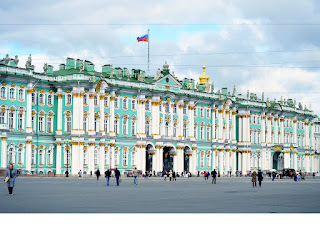 |
| Photo of Winter Palace in St. Petersburg Russia by islandworks at https://pixabay.com/photos/hermitage-st-petersburg-s-2612663/ |
This world history resource focuses on revolutions
and nationalism during the years between 1900 and 1939
and includes quiz questions and answers and video links to related topics.
I utilized World History: Patterns of Interaction (Holt McDougal)
for our world history textbook. It has multiple options for
different learning styles and covers a wide array of information.
This quiz accompanies Chapter 30: pages 864-893.
Directions for the quiz:
- Scroll down and click on the thumbnail to enlarge to full screen.
- Click on the graphic to advance to the next screen.
- Choose an answer for each question.
- Compare your answers with those provided.
If you are interested in a group and/or interactive version of this quiz,
log in to Kahoot! and search for Week 30 World History by Katrena.
Below are free videos to accompany chapter 30:
Thanks for visiting my Student Survive 2 Thrive blog.
Navigate my blog easily through my site map, topics
tabs on the right, or via my search bar.
Here are a few of my articles you may also find helpful this week:
 |
| World History Week 30: Revolution and Nationalism 1900-1939 |
 |
| Created by Katrena. All rights reserved. |
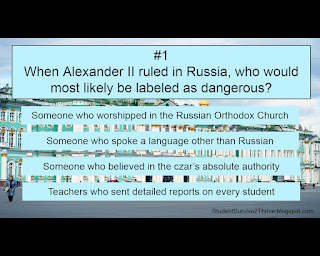 |
When Alexander II ruled in Russia, who would most likely be labeled as dangerous?
Answer choices include:
Someone who worshipped in the Russian Orthodox Church,
Someone who spoke a language other than Russian,
Someone who believed in the czar’s absolute authority,
Teachers who sent detailed reports on every student |
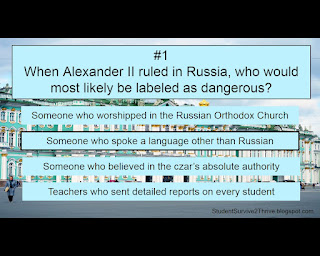 |
The correct answer is:
Someone who spoke a language other than Russian |
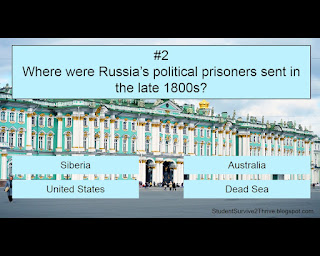 |
Where were Russia’s political prisoners sent in the late 1800s?
Answer choices include: Siberia, Australia, United States, Dead Sea |
 |
| The correct answer is Siberia. |
 |
In 1917, Russians revered ___ as the “Father of the Revolution.”
Answer choices include: Bolsheviks, Gorbachev, Rasputin, Lenin |
 |
| The correct answer is Lenin. |
 |
What was FALSE regarding industrialization of Russia in the late 1800 & early 1900s?
Answer choices include:
There were poor working conditions & child labor.
Wages were high and led to an improved economy.
Some workers organized strikes.
The Trans-Siberian Railway connected western Russia with the eastern coast. |
 |
| The correct answer is: Wages were high and led to an improved economy. |
 |
What happened after ~200,000 workers/families asked for better conditions, more freedom & an elected legislature at Winter Palace?
Answer choices include:
The czar agreed to their petition & signed it into law.
The czar was not at the palace & they were told to go home.
The czar said he would read the petition & ignored their requests.
Soldiers fired on the crowd, wounding >1000 & killing hundreds. |
 |
| The correct answer is: Soldiers fired on the crowd, wounding >1000 & killing hundreds. |
 |
When Czar Nicholas II moved his headquarters to the war front,
his wife ran the government while being advised by Rasputin.
Answer choices include: true, false |
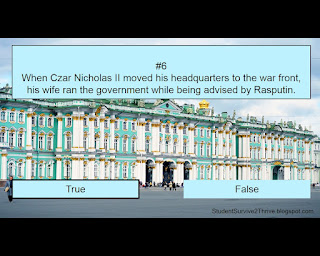 |
| The correct answer is true. |
 |
Vladimir Lenin’s Union of Soviet Socialist Republics (USSR) resulted in a
“dictatorship of the proletariat” in which peasants owned all of the country’s wealth.
Answer choices include: true, false |
 |
| The correct answer is false. |
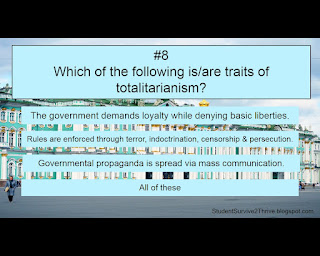 |
Which of the following is/are traits of totalitarianism?
Answer choices include:
The government demands loyalty while denying basic liberties.
Rules are enforced through terror, indoctrination, censorship & persecution.
Governmental propaganda is spread via mass communication.
All of these |
 |
| The correct answer is all of these. |
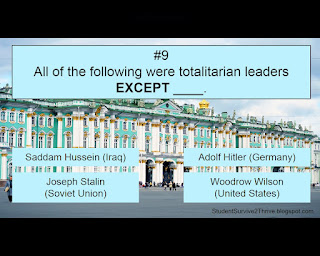 |
All of the following were totalitarian leaders EXCEPT ____.
Answer choices include: Saddam Hussein (Iraq), Adolf Hitler (Germany),
Joseph Stalin (Societ Union), Woodrow Wilson (United States) |
 |
| The correct answer is Woodrow Wilson (United States). |
 |
The Great Purge resulted in the death of ___ people in the USSR.
Answer choices include:
8,000-13,000; 80,000-130,000; 800,000-1,300,000; 8-13 million |
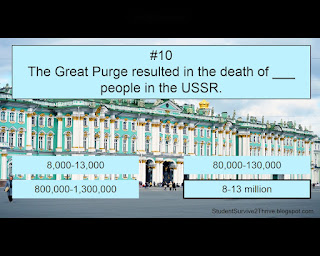 |
| The correct answer is 8-13 million. |
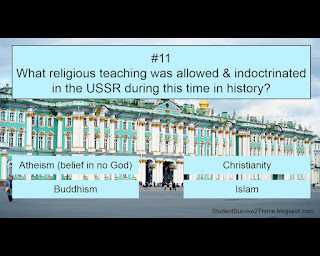 |
| What religious teaching was allowed & indoctrinated in the USSR during this time in history? Answer choices include: Atheism (belief in no God), Christianity, Buddhism, Islam |
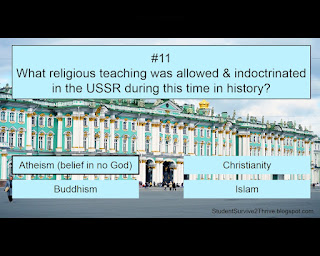 |
| The correct answer is Atheism (belief in no God). |
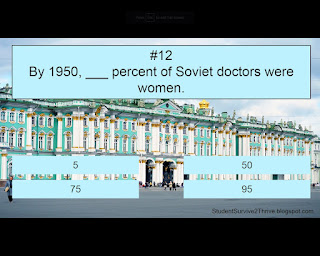 |
By 1950, ___ percent of Soviet doctors were women.
Answer choices include: 5, 50, 75, 95 |
 |
| The correct answer is 75. |
 |
___ overthrew the Qing Dynasty & hoped to establish
a modern government based on nationalism,
democracy & economic security for China.
Answer choices include:
Mao Zedong, Sun Yixian, Jiang Jieshi, Joseph Stalin |
 |
| The correct answer is Sun Yixian. |
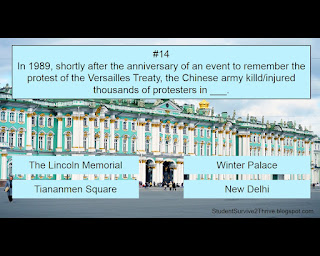 |
In 1989, shortly after the anniversary of an event
to remember the protest of
the Versailles Treaty, the Chinese army killd/injured
thousands of protesters in ___.
Answer choices include:
The Lincoln Memorial, Winter Palace, Tiananmen Square, New Delhi |
 |
| The correct answer is Tiananmen Square. |
 |
Chinese Communists traveled 6,000 miles on foot,
crossing 18 mountain ranges
& 24 rivers to flee from the Nationalist forces.
This is called the ___.
Answer choices include:
Long March, Trail of Tears, Grueling Hike, Tea Party |
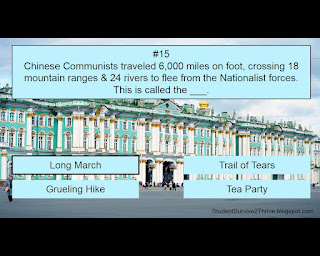 |
| The correct answer is Long March. |
 |
Chinese Nationalists & Communists unexpectedly began to work
together because ___ invaded China.
Answer choices include: Russia, Turkey, Germany, Japan |
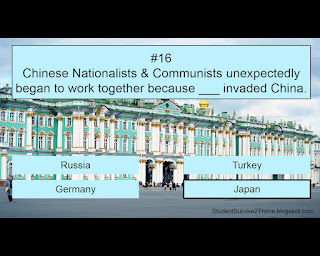 |
| The correct answer is Japan. |
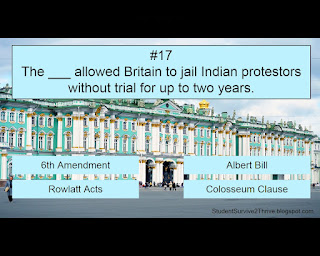 |
The ___ allowed Britain to jail Indian protestors
without trial for up to two years.
Answer choices include:
6th Amendment, Albert Bill, Rowlatt Acts, Colosseum Clause |
 |
| The correct answer is Rowlett Acts. |
 |
___ was an Indian leader who encouraged civil disobedience &
nonviolence to achieve independence after the Amritsar Massacre.
Answer choices include: Mohandas Gandhi, Muhammad Ali,
Mustafa Kemai, Sir Daniel Hamilton |
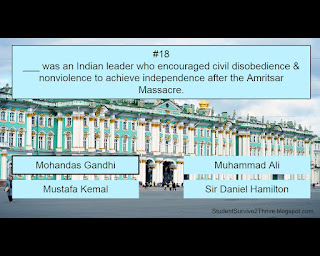 |
| The correct answer is Muhandas Gandhi. |
 |
An Indian boycott of British ___ and ___ created
an economic burden on Britain.
Answer choices include:
wheat/rice, coal/oil, cloth/salt, opium/tobacco |
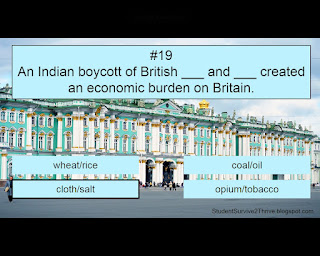 |
| The correct answer is cloth/salt. |
 |
Mustafa Kemal successfully led nationalists
to overthrow the last Ottoman sultan in ___.
Answer choices include:
Spain, Turkey, China, Saudi Arabia |
 |
| The correct answer is Turkey. |
 |
| Find more resources at StudentSurvive2Thrive.blogspot.com |












































No comments:
Post a Comment
Thanks for reading my article and sending your comment! Please note that I do not place links to other web sites on this blog.
Note: Only a member of this blog may post a comment.